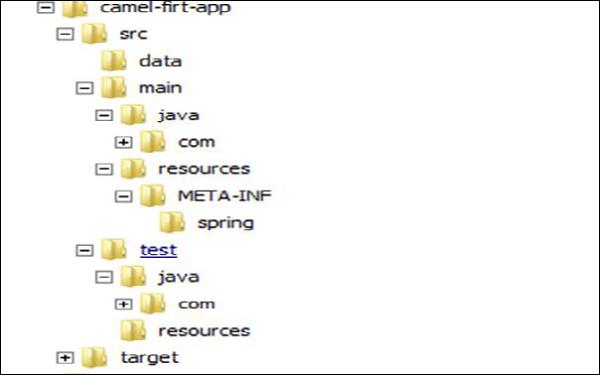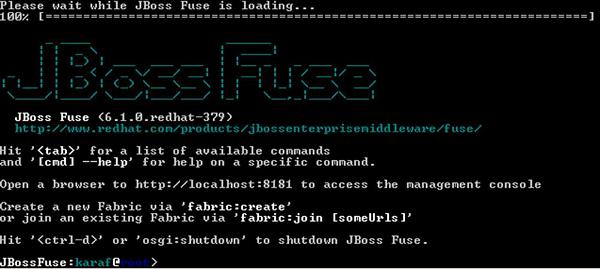JBoss Fuse - Apache Camel
In this chapter, we will discuss what Apache Camel is and how it effectively routes data between endpoints, along with a few examples.
What is Apache Camel?
Apache Camel is an open source integration framework which was started in early 2007.
It is an EIP (Enterprise Integration Pattern) based approach which provides several out of the box patterns implementations that can be used to solve enterprise integration problems. EIP are nothing but proven solutions to the well documented and recurring problems in enterprise integration.
Camel is also known as routing and mediation engine as it effectively routes data between endpoints, while taking heavy load like transformation of data formats, endpoint connectivity and many more.
Basic Example
The prerequisites to use Apache Camel are −
- Java
- Maven
- Redhat JBoss Fuse 6.1-GA-379
Create basic skeleton of Application
mvn:archetype generate
–DgroupId = com.tutorialpoint.app
–DartifactId = camel-first-app
–DarchetypeGroupId = org.apache.camel.archetypes
–DarchetypeArtifactId = camel-archetype-spring
–DinteractiveMode = false -X
This should generate the following directory structure.

This is a basic skeleton of our Camel application being generated.
Edit camel-context.xml
Edit camel-first-app → src → main → resources → META-INF\spring\camel-context.xml to match as below
<?xml version = "1.0" encoding = "UTF-8"?>
<!-- Configures the Camel Context-->
<beans xmlns = "http://www.springframework.org/schema/beans"
xmlns:xsi = "http://www.w3.org/2001/XMLSchema-instance"
xsi:schemaLocation = "http://www.springframework.org/schema/beans
http://www.springframework.org/schema/beans/spring-beans.xsd
http://camel.apache.org/schema/spring
http://camel.apache.org/schema/spring/camel-spring.xsd">
<camelContext xmlns = "http://camel.apache.org/schema/spring">
<!-- here is a sample which processes the input file
(leaving them in place - see the 'noop' flag)
then performs content based routing on the message using XPath -->
<route>
<from uri = "file:///d:/src/data?noop=false"/>
<choice>
<when>
<xpath>/person/city = 'London'</xpath>
<log message = "UK message"/>
<to uri = "file:///d:/target/messages/uk"/>
</when>
<otherwise>
<log message = "Other message"/>
<to uri = "file:///d:/target/messages/others"/>
</otherwise>
</choice>
</route>
</camelContext>
</beans>
Edit pom.xml
Add the following code inside <plugins></plugins>
<plugin>
<groupId>org.apache.felix</groupId>
<artifactId>maven-bundle-plugin</artifactId>
<version>2.3.4</version>
<extensions>true</extensions>
<configuration>
<instructions>
<Bundle-SymbolicName>
${project.artifactId}
</Bundle-SymbolicName>
<Import-Package>*</Import-Package>
</instructions>
</configuration>
</plugin>
Change packaging type from jar → bundle.
<packaging>bundle</packaging>
Build the project using the following command −
mvn clean install
Install Project into Fuse
Start Fuse using Fuse.bat/start.bat. If you start Fuse using start.bat, use client.bat to connect to Fuse. You should get the UI as shown in the following screenshot.

This is the CLI for accessing Karaf and Fuse commands.
install –s mvn:com.tutorialpoint.app/camel-firt-app/1.0-SNAPSHOT
Test if your Project is Running
Now your application should be installed in Fuse. Copy data directory inside camel-first-app and place it in D:/src/ and it should copy message having city = London into D:/target/merssages/uk.
Place the input file in D:/src/data
Input
Message1.xml
<?xml version = "1.0" encoding = "UTF-8"?>
<person user = "james">
<firstName>James</firstName>
<lastName>Strachan</lastName>
<city>London</city>
</person>
Message2.xml
<?xml version = "1.0" encoding = "UTF-8"?>
<person user = "hiram">
<firstName>Hiram</firstName>
<lastName>Chirino</lastName>
<city>Tampa</city>
</person>
Output
In D:/target/messages/uk
<?xml version = "1.0" encoding = "UTF-8"?>
<person user = "james">
<firstName>James</firstName>
<lastName>Strachan</lastName>
<city>London</city>
</person>
In D:/target/messages/others
<?xml version = "1.0" encoding = "UTF-8"?>
<person user = "hiram">
<firstName>Hiram</firstName>
<lastName>Chirino</lastName>
<city>Tampa</city>
</person>




